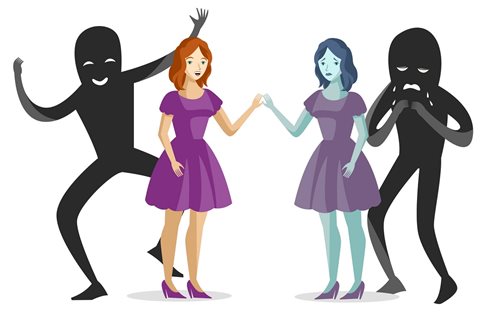March 21, 2018
By Cheryl Cranick

We do a great disservice to people diagnosed with bipolar disorder by ignoring the condition’s types. Too often I see "bipolar disorder" used alone, yet the illness actually exists on a spectrum.
For most of my teenage years, I struggled with sadness, lack of energy, rapid mood cycles and suicidal thoughts without knowing the cause of the symptoms. By age 16, I had been diagnosed with OCD and depression, but treatment wasn’t helping.
At age 20, my mother found a home screening test to determine if my depression might actually be bipolar disorder. When the results placed me on the spectrum, I was deeply confused. Based on my understanding of the disorder, its symptoms did not match what I experienced. My dominant symptom was depression, and I never reached mania.
After receiving a formal diagnosis from a mental health professional, I began to better understand how I could have bipolar disorder without the "typical" symptoms I had heard so often. My condition is bipolar II disorder—I just didn’t know there was more than one type.
This was back in the early 2000s, when talking about mental health was still rather hushed. While, we know more now, and we talk more about mental illness, it still seems the bipolar disorder types are often left out.
Beyond the occasional reference to Types I and II, bipolar disorder is usually grouped as one condition. Ignoring the spectrum prevents the public from better understanding the complexity of this illness, and what’s worse is the prevalence of misdiagnosis. Studies have found 40% of patients with bipolar disorder were initially diagnosed with unipolar (major depression). This does not surprise me. With bipolar II disorder specifically, depression is usually the most common or stronger symptom of the high/low mood scale, whereas manic symptoms may go unreported to a doctor because the elevated (or increased) mood is not severe enough to affect the person's life.
For those who don't know the difference—or want to easily explain the difference to others—I often hold up my two hands. One hand is unipolar (depression). The other hand is bipolar I (manic depression). What exists in the middle is the bipolar II spectrum. Unfortunately, the spectrum is wide and unique to each person.
You can also think of the bipolar spectrum as a hill, with unipolar (depression) at the bottom and bipolar (manic depression) at the top. The space between the upward curve is the spectrum and each person with bipolar II disorder exists somewhere along it. The closer a person’s symptoms are to one end, the more likely that person is to receive a diagnosis of major depression or manic depression.
With bipolar I, the mania is usually quite clear. In bipolar II, the mania is "milder." Depression is usually present in both, and may be more severe and prevalent in bipolar II. However, these conditions rarely feature across-the-board symptoms for everyone. It's the cluster of symptoms that need to match up for a diagnosis.
I am somewhere in the middle. My lows are low and have reached suicide ideation. My mania, however, is classified as "hypo," and expresses itself in behaviors such as talking faster than normal, staying up late with lots of energy or being quick to anger.
The spectrum is not new to people who live with the disorder, but it is news to many. As a NAMI In Our Own Voice presenter, two responses I received during presentations last year have stuck with me.
After sharing my story at a CIT training, one officer asked me: "How am I able to help people in my community if I don't even know this exists?"
Months later, while speaking at a NAMI Family-to-Family class, a woman told me about her husband, noting his depression treatment was not working. Visibly relieved, she said: "I've never heard of this. I think you just diagnosed my husband, daughter and sister-in law."
While only a health care professional can diagnose, we must be active self-advocates and educators. We must be clear when referencing this illness in hopes that fewer people will endure the pain and frustration that comes with misdiagnosis.
For more information on the bipolar spectrum, check out the book: Why Am I Still Depressed? Recognizing and Managing the Ups and Downs of Bipolar II and Soft Bipolar Disorder by Jim Phelps.
Cheryl Cranick fictionalized her bipolar II misdiagnosis and severe weight gain into a novel titled "Becoming" (http://www.cherylcranick.com). The book hopes to educate about bipolar II and encourage empathy, as her character struggles through college. Cheryl lives with her two rescue dogs in Jupiter, FL.
Note: An earlier version of this blog appeared on NAMI.org in February 2017.
We’re always accepting submissions to the NAMI Blog! We feature the latest research, stories of recovery, ways to end stigma and strategies for living well with mental illness. Most importantly: We feature your voices.
LEARN MORENAMI HelpLine is available M-F, 10 a.m. – 10 p.m. ET. Call 800-950-6264,
text “NAMI” to 62640, or email. In a crisis, call or text 988 (24/7).